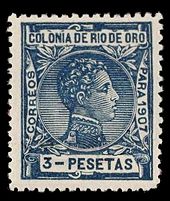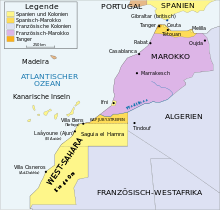Río de Oro
![]()
The title of this article is ambiguous. For other meanings, see Río de Oro (disambiguation).
Río de Oro was the southern of the two provinces of the former Spanish colony of Spanish Sahara. Together with the northern province of Saguia el Hamra, it is now part of the largely Moroccan-administered territory of Western Sahara. The name, which translates as "gold river", comes from a dry riverbed (wadi) in the centre of the area.
The total area was 184,000 km². The capital of the province was the port of Ad-Dakhla, called Villa Cisneros in Spanish times.
In 1975 Spain withdrew its troops and handed over its colonial possessions to its southern and northern neighbours, Morocco and Mauritania.
The 26th parallel formed the northern border and through the territory runs the Tropic of Cancer. The southern border began at Cabo Blanco, which forms a peninsula where the second most important town, La Gouira, is located. This peninsula continued to be occupied by Mauritania, although it withdrew from the rest of the territory it had taken from Spain before its recognition of the newly formed state of Saharan Arab Democratic Republic between 1976 and 1979.
The boundary between the zones of the former Spanish colonies administered by Mauritania and Morocco was a line that began in the coastal area north of Villa Cisneros or Dakhla at 24° north latitude and ran east to the Mauritanian border at 23° latitude.
The original name Rio do Ouro goes back to Portuguese merchants who exchanged their goods for gold dust in 1442 and therefore believed to be here at the mouth of the gold-rich state of Mali under Mansa Musa, which became famous in Europe in the 14th century, although gold was never found there but only further south in Akjoujt and in the gold country of the Wangara south of the Niger. Some historical maps - such as one from 1529 by Diego Ribera - show a river course from the heart of black Africa to the Atlantic, while more recent maps show a much shorter riverbed running out in the Gulf of Wadi Megeta Mersug, although a Spanish government expedition concluded as early as 1886 that there was no river at all. The cause of the error may be the long and narrow shape of the gulf, which led early explorers to mistake it for a river mouth.

From 1905 to 1924, Río de Oro formed a postal territory with its own stamp issues. Stamp of 3 peseta with the portrait of King Alfonso XIII from 1907.

Map of Spanish Sahara with the province of Río de Oro
Search within the encyclopedia